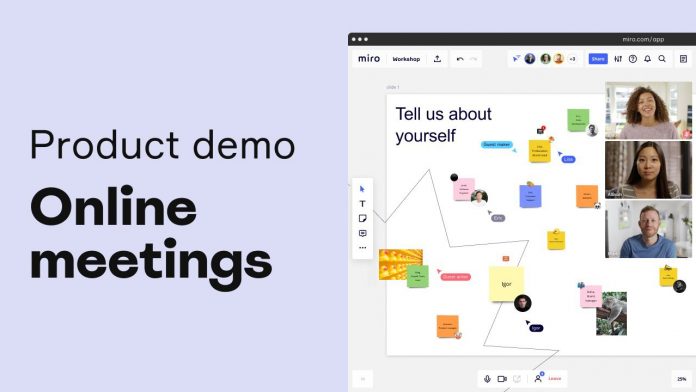Our Miro review profiles the pros and cons of this collaboration and whiteboarding tool for creatives.
Collaborating as a creator in a remote team is a challenge. You’ll constantly need to jump on video calls to ensure everyone is on the same page. It’s also challenging for copywriters, designers, and website owners to collaborate on these types of projects if they’re working in different locations.
Enter Miro. With its infinite canvas whiteboard, you can jot down ideas and see what teammates are working on in real-time. This easy collaboration allows you to solve problems quicker and improve employee productivity.
In this Miro review, I’ll guide you through everything you need to know about Miro as a creative professional. I’ll go over my experiences, who it’s for, the pros and cons, and if it’s worth your time and money.
What Is Miro?
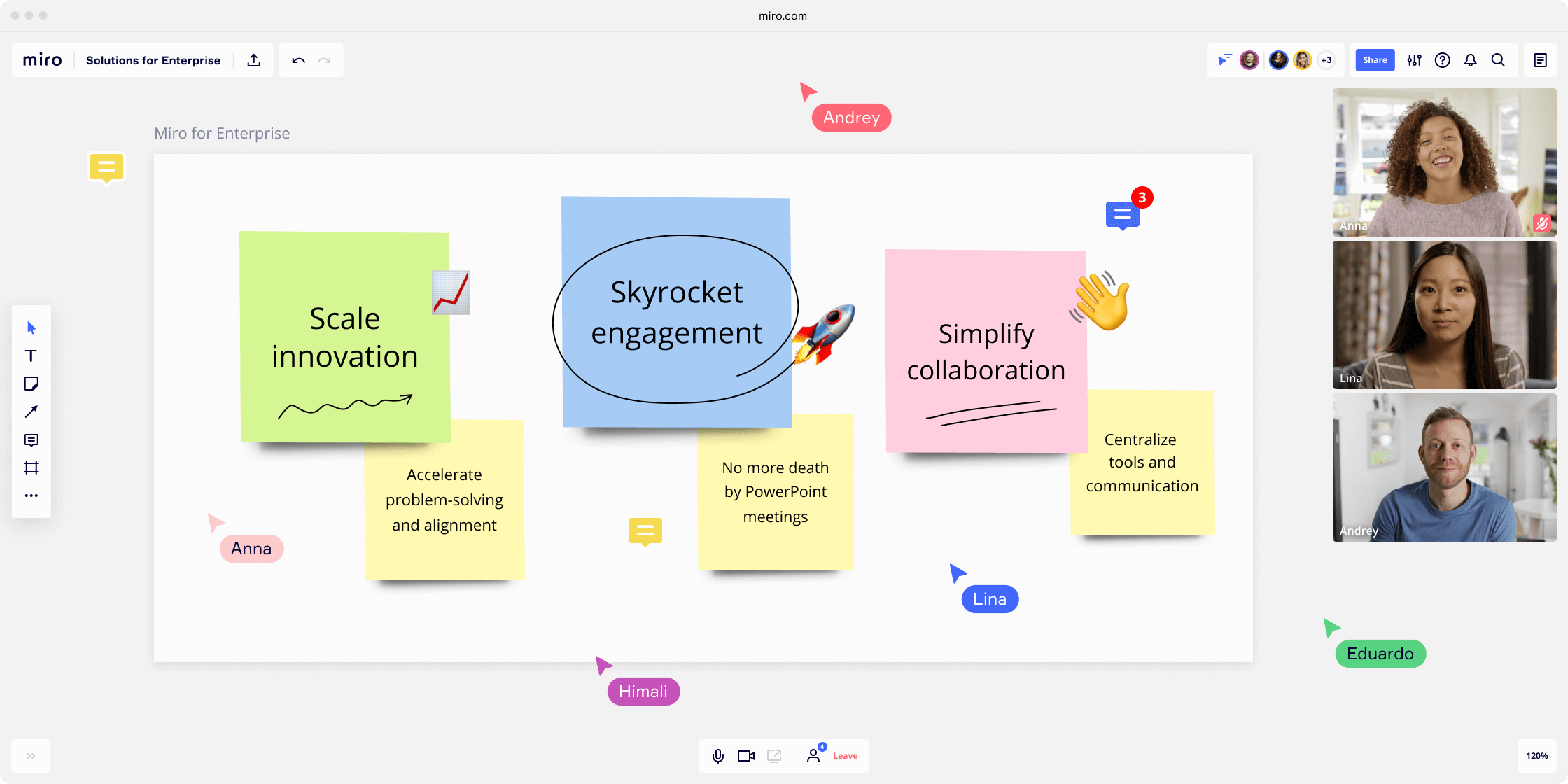
Andrew Khusid founded Miro in 2011 after realizing how difficult it is for web teams and creatives to brainstorm and collaborate online.
Miro is an online whiteboard platform. Everything you can do on a physical whiteboard is possible in Miro. It’s almost like the Google Docs of whiteboard tools. You can also see what your teammates are working on in real-time, making for effortless collaboration.
Basically, a creative team can work together to wireframe, prototype or mockup a project in real-time. They can also use Miro to collaborate in a type of virtual meeting in real-tome. It’s like a whiteboard, marketing, project management, and brainstorming tool in one.
Here are some additional Miro features:
- Detailed pre-built offline templates
- Helpful project management tools
- Customer journey mapping
A few years after developing Miro, Khusid attracted millions of teams to the software, including Cisco, Pivotal, Okta, Deloitte, and Accenture. Co-headquartered in San Francisco and Amsterdam, today, Miro has offices in several cities like:
- Austin
- London
- New York
- Tokyo
- San Francisco
Miro Pricing
When signing up for Miro, you’ll have four pricing options:
- A free plan
- The Team plan costs $10 per month or $96 per year
- The Business plan costs $20 per month or $192 per year
- An Enterprise plan
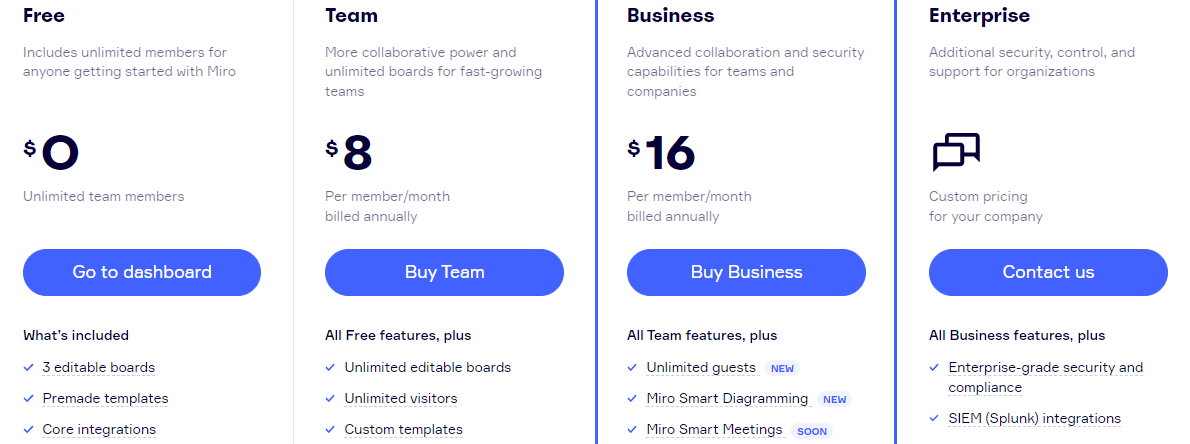
What I like about Miro is how flexible their free plan is. It offers unlimited team members, three editable boards, access to all premade templates, and core integrations. Compared to other collaboration platforms, you can get a lot done with the Miro free plan.
This way, if you don’t want to take any risk, sign up for the free plan, invite teammates, and start collaborating. Once you’ve gotten the hang of Miro, consider the Team plan.
With Miro’s Team plan, you access more advanced features like:
- Customer templates
- Projects and unlimited editable boards
- Unlimited visitors
- Private sprint boards
What sets Miro apart is it grows with your team. So when scaling your business, opt for the Business plan because it makes collaboration and project management more straightforward. You’ll find new features like Miro Smart Diagramming, Miro Smart Meetings, and unlimited guests.
If you manage hundreds of employees, you’ll need the Enterprise plan. There’s no price on the Miro website, so you’ll need to contact sales, and they’ll build a custom plan for you.
With the Enterprise plan, you’ll find valuable features like:
- SIEM (Splunk) integrations
- Data governance
- Azure DevOps and CA rally integrations
- Premium support
- A dedicated success manager
This dedicated success manager ensures your team uses Miro to its full potential. It’s like you have your own manager helping you reach your business goals.
Who Is Miro For?
Miro can benefit the lives of:
- Creative teams e.g. designers and copywriters
- Website publishers
- Small business owners
- Engineers and STEM students
Creative Teams
When Khusid built Miro, he designed it for creative teams. He developed features like Smart Meetings and editable boards to make collaboration and brainstorming across the globe straightforward.

While everyone uses the whiteboard to brainstorm ideas, you can track their progress. This real-time feedback allows for quick idea generation and productive sprints.
Website owners and content publishers, for example, can also use Miro to wireframe or plan what they want a site to look like before building it.
Similarly, if your team develops a new software feature, invite everyone to Miro and use the digital whiteboard to get creative juices flowing.
Also, if you use Kanban, Jira, or Asana, you can integrate Miro with these team systems to engage with other designers or copywriters.
Business Owners
As a business owner, Miro is a must-have because of the infinite canvas on your dashboard. Feel free to zoom in and zoom out as much as you want. This helps because you can have multiple product strategies and management exercises on the same board.
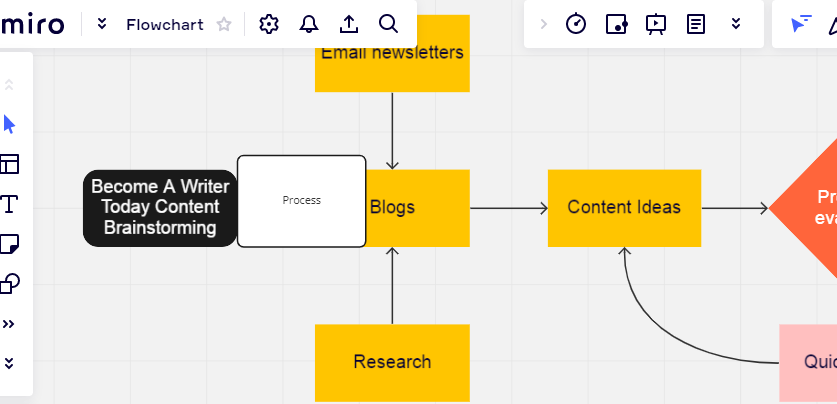
There’s a permissions icon in the top-right of your infinite canvas. If you’re jotting down a few ideas and only want a select few colleagues to access it, use the permissions. This way, you’ll have complete control over your document.
You can even see as people move their cursor, which helps determine what part of the board everyone is focusing on.
Engineers And STEM Students
Miro offers several functional technical diagrams that empower the lives of engineers, STEM students, or anyone in a highly specialized field. With a click of a few buttons, create colorful flowcharts to visualize and understand complicated systems. This visualization helps identify dependencies and siloed information, improving work processes.
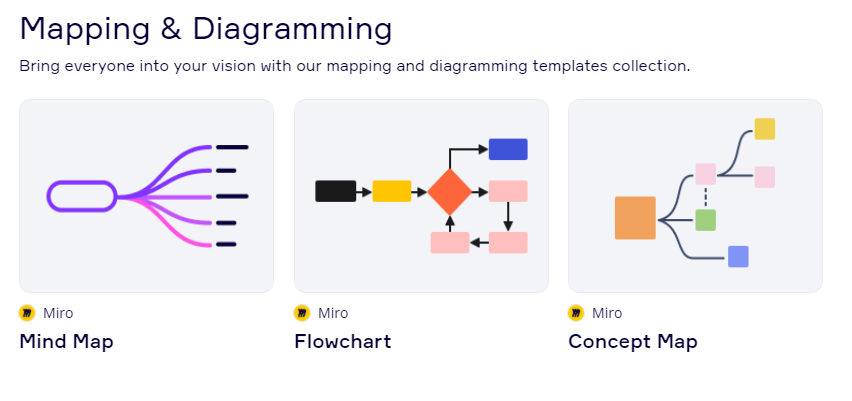
But what sets Miro apart from other collaborative tools is its knowledge hub. Many teams struggle to work together because each individual follows a different work system. This causes technical teams to work in silos and hunt for critical information.
With Miro’s knowledge hub, centralizing requirements and best practices take seconds. This way, engineers can add information to the knowledge hub, make it accessible to everyone, and entire teams work as one.
It also helps to give everyone editing access to this hub because if someone runs into a problem, they can share it with the team. And if anyone else encounters the same problem, they can simply visit the knowledge hub.
Even if you’re a college student studying STEM subjects, you can benefit from using Miro. Collaborating with other students remotely is easy, and you can work together when creating complex assignments.
Now that we know who Miro is for, let’s cover how it works.
How Does Miro Work?
When signing up for Miro, head over to Miro.com, and in the top-right hand corner, you’ll see a signup button. Select this option and sign up with your Google, Facebook, or email account. Miro will ask a few questions to help tailor the platform to your needs.
Once you’re on the dashboard, you’ll notice it’s empty because you don’t have any existing boards. So select “New Board,” and you’ll have the option between several pre-built templates or to continue without one.
These pre-built templates include:
- Mind maps
- Customer journey maps
- Brainwriting
- User story maps
- Kanban or Scrum boards
The best way to get a feel for Miro is to explore the templates and build boards around them. After selecting a board or continuing without one, you can reshape and change the content to fit your needs.
For example, on the left-hand side of your infinite canvas, you’ll find sticky notes, cards, and lines to fill in your Miro board. Once you’ve customized your board, you can add additional context like what product or service this board relates to. You can also use tags to assign a task to a specific team member.
Now let’s look at some of my favorite features.
Smart Meetings
Miro Smart Meetings can help save time and money. Gone are the days when you needed to organize physical meetings. With Smart Meetings, you can complete this entire process within a few minutes.
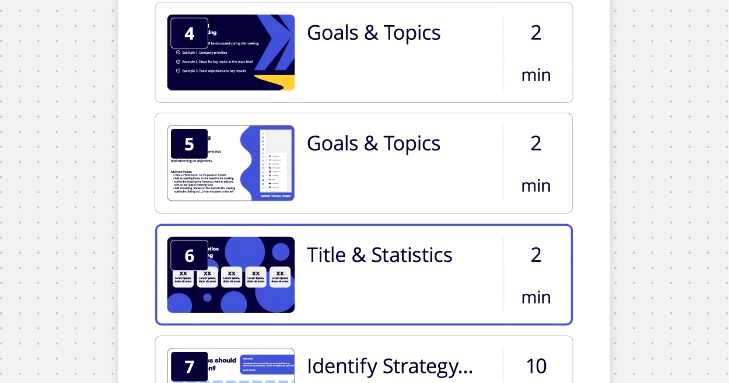
Miro Smart Meetings is a collection of simple tools that allow you to take team meetings to the next level. These meetings are more engaging and fun because you can launch activities and organize people into breakouts for smaller group collaboration.
There’s a feature within Smart Meetings where you can lock participants to linked frames. When running a workshop, it’s always annoying when people go everywhere on the board and drag you away from your topic.
With this feature, you can lock participants in one frame or working space, and this control allows for more productive meetings.
20+ Integrations
Because your entire team can brainstorm ideas on the infinite whiteboard while integrating with other platforms, Miro is perfect for product management. You can connect brainstorming campaigns with popular tools like:
- Zoom
- Slack
- Asana
- Trello
- Google Drive
- Microsoft Teams
The plugin that stood out to me is Miro for Zoom. You access all Miro brainstorming features when running Zoom meetings. With this screen sharing, you don’t need to toggle between the Zoom and Miro apps. It’s almost like your entire team is sitting in a room together with a whiteboard generating ideas.
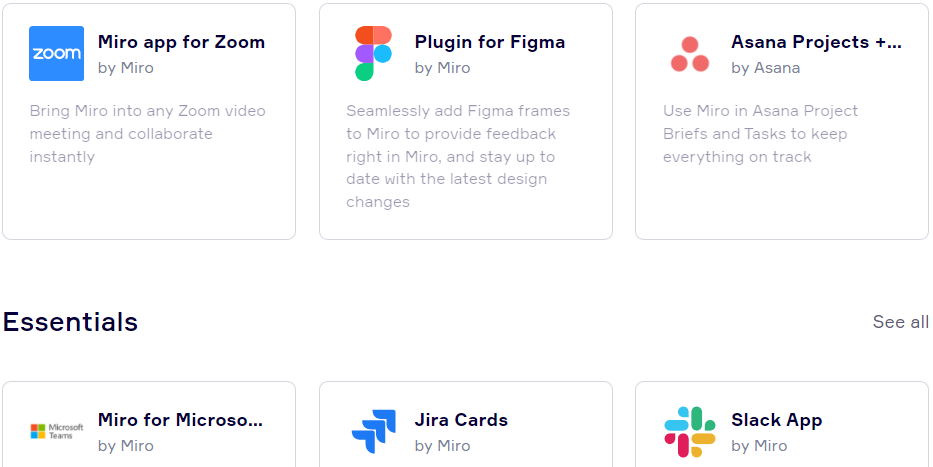
Another plugin that helped me is Timer for Miro. You’ll find this timer in the bottom-left corner under the Collaboration Toolbar. It allows your team to track time while working or running a workshop. So you won’t have to use a third-party time tracker.
And because Miro is constantly developing and introducing new features, you can expect this list of integrations to grow.
Mind Map And Flowcharts
Miro roadmaps and flowcharts are valuable if you want to visualize work processes and customer journeys.
This isn’t just handy for engineers or technical individuals. Marketers and UX designers can use this to find sticking points and streamline the user experience. It helps you map out a visual flow when interacting with a system, whether that system is your software or marketing campaign.
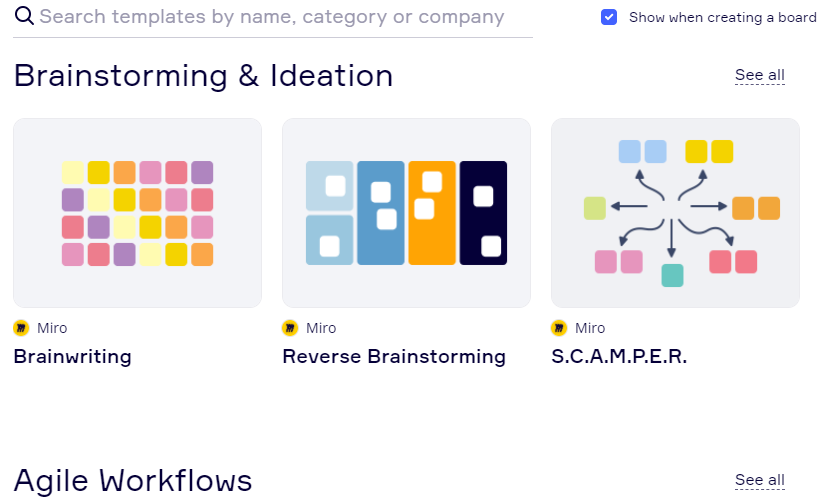
One of my favorite flowcharts is the UML diagram template. UML stands for unified modeling language and is a popular approach to structuring applications.
You can map out processes step-by-step, add them to the knowledge hub, and team members can view this process. Your team will visualize the relationship between tasks and systems, which helps bring new employees up to speed.
Areas For Improvement
After using Miro to map out creative processes and marketing strategies, I noticed a few drawbacks:
- It doesn’t offer consulting for lower-tier subscriptions
- The interface glitches occasionally
No Dedicated Support For Lower-Tier Subscriptions
You receive a dedicated customer success manager when signing up for the Miro Enterprise plan. This success manager makes sure your team uses Miro to its full capabilities and helps maximize success.
However, I noticed Miro doesn’t offer this with other plans. I’m not expecting Miro to give every user their own success manager since it’s expensive. But a consulting feature where you can connect with someone occasionally to help you get the most out of Miro will be helpful.
Without consulting, smaller Miro teams can’t fully utilize this complex tool. I’d like Miro to introduce a feature where smaller teams can connect with a success manager.
Interface Glitches Occasionally
When creating arrows from one side of the same shape, I noticed some disappear after visiting the board again. This can be annoying when you’re working with a large team and collaborating over Smart Meetings or Miro for Zoom.
Also, sometimes you’ll add a note to a template, and when revisiting it, it’ll disappear. These issues aren’t significant. They’ll probably annoy your team from time to time, but it’ll be nice to have Miro remove all these glitches.
Miro Review Criteria
When reviewing Miro to see if it’s a practical whiteboard software, I used the following criteria:
- Ease of use
- Functionality
- Additional features
- Affordability
I found that Miro comfortably meets all these criteria. It’s super easy to use. When signing up, Miro gives you a few video tutorials that explain everything so you get a feel for the whiteboard. There isn’t much of a learning curve since the dashboard is simple.
Miro is also a functional team collaboration tool. The infinite canvas and templates make it easy to get your creative juices flowing. Combined with Smart Meetings, it’s almost like your team is sitting in a room working on projects together.
You’ll find additional features like:
- Robust widgets
- Customer journey maps
- Smart Meetings
- Miro for Zoom
Miro is more than just an agile whiteboard tool. Collaboration is straightforward with these features, and you can improve marketing strategies and user experience.
If you’re on a budget, you’ll be happy to know that Miro is quite affordable. You can sign up for a free trial, and there’ll be no risk on you.
You’ll only need $10 per month or $96 per year to upgrade. And when you scale your team, Miro grows with you. The Business plan sets you back $20 per month or $192 per year. Consider the Enterprise plan if your company size is bigger than 50 employees. Miro works out a custom plan for you, and you’ll even get a dedicated customer success manager.
Why You Can Trust Me
After writing articles for years, I never thought of mapping out my workflow and marketing processes to find sticking points. But when I used Miro’s mindmap, I found that I built outlines from scratch for every article. This takes up valuable time when I can simply use templates to streamline this part of my creative process.
These pre-built templates also help with emails because I don’t have to proofread each email three or four times. Using Miro’s mindmap, I identified sticking points and saved myself precious time.
When brainstorming content ideas with my team, instead of using Zoom and a separate tool to jot down ideas, I can simply use Miro’s video conferencing feature. This makes my meetings more engaging because I don’t have to go back and forth between apps.



